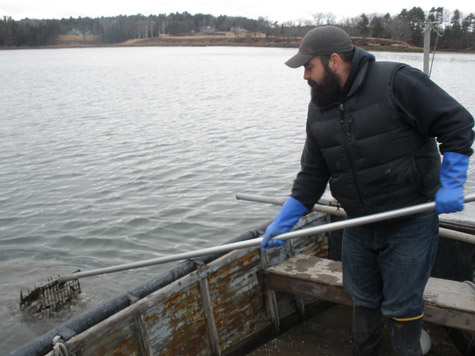
RAKING OUT THE BEDS John Hennessey of Winter Point Oysters reaps another harvest. |
While awaiting brunch at Vignola one Sunday afternoon, the server surprised us with two oysters on the half-shell, topped with vibrant pomegranate seeds. As we slurped them down, the sweetness and slight saltiness combined with the tartness of the pomegranate for a delectable experience.
A few weeks later I sat down with the Lee Skawinski, the executive chef and co-owner of Vignola and Cinque Terre, to discuss local products on his menus (see the upcoming spring issue of Portland Style magazine for that story). During our discussion, the oysters came up again.
"We have some of the best oysters, and the best micro-aquaculture, in the world and the way the oysters are done in Maine, because of the quality of the water and the situation with the water temperature is ideal," Skawinski told me. "They stand out around the world."
I went in search of the origins of these world-class tastes. As John Hennessey, co-owner of Winter Point Oysters, drove me to a cove in West Bath whose exact location he asked remain a secret, he took special care to note the significance of the family land. We passed Grandma's house and mounds in the fields caused by horses plowing and harvesting generations ago. This land has been in his family for more than 300 years, with evidence it was deeded directly from the king of England.
Hennessey's dad and uncle started farming and harvesting oysters in the mid-'90s as a way to help pay the taxes, and, what started as a side business has become a full-time career for Hennessey and his cousin and business partner, Ryan Curran.
"It dominates your life, in a good way," he says. "I think half the conversations I've had with my uncle and father have been about the oyster farm — trying to come up with new and crazy ideas."
Even after 15 years in business, it's still trial and error. "There's no book on how to do this and what works here may not work in other places," he says. He attributes the quality of his oysters to the unique location. The cove is well protected from wind and other elements by surrounding islands. Its combination of salt and fresh water, plus the dense clay of the mud flats, provides ideal growing conditions.
But it's not the quality of the oysters that's been most challenging — it's the quantity. "We can't grow enough to meet demand. We ran out last year," he says. "We would love to be able to supply everyone, but we literally don't have enough."
Out on the boat he showed me how they rake the beds two to four times a week, and I noticed there were no markers. Apparently that's on purpose. While there's no contention with the clam diggers and others who come through this cove, it would just take one person to damage years' worth of work, considering the American oysters take about three years to mature.
Harvesting is the part Hennessey loves and while he doesn't aspire to be a salesman, he understands the importance of building his brand, and delivering the consistency that local chefs and distributors demand. He puts 101 oysters in each bag, the extra one in case a "rattler," or dead one, gets in there, that's his last-ditch safety move.